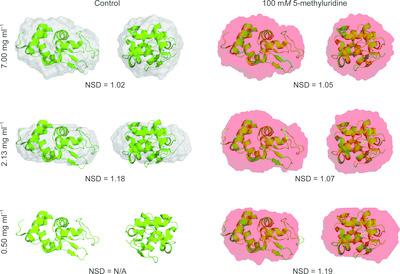当前位置:
X-MOL 学术
›
Acta Cryst. D
›
论文详情
Our official English website, www.x-mol.net, welcomes your feedback! (Note: you will need to create a separate account there.)
Improving data quality and expanding BioSAXS experiments to low‐molecular‐weight and low‐concentration protein samples
Acta Crystallographica Section D ( IF 2.2 ) Pub Date : 2020-10-08 , DOI: 10.1107/s2059798320010700 Albert Castellví 1 , Carlos Pascual-Izarra 1 , Eva Crosas 2 , Marc Malfois 1 , Judith Juanhuix 1
Acta Crystallographica Section D ( IF 2.2 ) Pub Date : 2020-10-08 , DOI: 10.1107/s2059798320010700 Albert Castellví 1 , Carlos Pascual-Izarra 1 , Eva Crosas 2 , Marc Malfois 1 , Judith Juanhuix 1
Affiliation

|
The addition of compounds to scavenge the radical species produced during biological small‐angle X‐ray scattering (BioSAXS) experiments is a common strategy to reduce the effects of radiation damage and produce better quality data. As almost half of the experiments leading to structures deposited in the SASBDB database used scavengers, finding potent scavengers would be advantageous for many experiments. Here, four compounds, three nucleosides and one nitrogenous base, are presented which can act as very effective radical‐scavenging additives and increase the critical dose by up to 20 times without altering the stability or reducing the contrast of the tested protein solutions. The efficacy of these scavengers is higher than those commonly used in the field to date, as verified for lysozyme solutions at various concentrations from 7.0 to 0.5 mg ml−1. The compounds are also very efficient at mitigating radiation damage to four proteins with molecular weights ranging from 7 to 240 kDa and pH values from 3 to 8, with the extreme case being catalase at 6.7 mg ml−1, with a scavenging factor exceeding 100. These scavengers can therefore be instrumental in expanding BioSAXS to low‐molecular‐weight and low‐concentration protein samples that were previously inaccessible owing to poor data quality. It is also demonstrated that an increase in the critical dose in standard BioSAXS experiments leads to an increment in the retrieved information, in particular at higher angles, and thus to higher resolution of the model.
中文翻译:

提高数据质量并将BioSAXS实验扩展到低分子量和低浓度蛋白质样品
添加化合物以清除在生物小角度X射线散射(BioSAXS)实验中产生的自由基物种是减少辐射损伤影响并产生更好质量数据的常用策略。由于几乎一半导致结构沉积在SASBDB数据库中的实验都使用了清除剂,因此发现有效的清除剂对许多实验都是有利的。在这里,我们提出了四种化合物,三种核苷和一种含氮碱,它们可以作为非常有效的自由基清除添加剂,并在不改变稳定性或降低被测蛋白溶液对比度的情况下,将关键剂量增加多达20倍。这些清除剂的功效高于迄今为止在该领域中常用的清除剂,经7.0至0.5 mg ml各种浓度的溶菌酶溶液验证-1。这些化合物在减轻分子量为7至240 kDa且pH值为3至8的四种蛋白质的辐射损伤方面也非常有效,极端情况是6.7 mg ml -1的过氧化氢酶,清除因子超过100。因此,这些清除剂有助于将BioSAXS扩展到以前由于数据质量差而无法获得的低分子量和低浓度的蛋白质样品。还证明了在标准BioSAXS实验中临界剂量的增加会导致所获取信息的增加,尤其是在较大角度下,从而导致模型的分辨率更高。
更新日期:2020-10-08
中文翻译:

提高数据质量并将BioSAXS实验扩展到低分子量和低浓度蛋白质样品
添加化合物以清除在生物小角度X射线散射(BioSAXS)实验中产生的自由基物种是减少辐射损伤影响并产生更好质量数据的常用策略。由于几乎一半导致结构沉积在SASBDB数据库中的实验都使用了清除剂,因此发现有效的清除剂对许多实验都是有利的。在这里,我们提出了四种化合物,三种核苷和一种含氮碱,它们可以作为非常有效的自由基清除添加剂,并在不改变稳定性或降低被测蛋白溶液对比度的情况下,将关键剂量增加多达20倍。这些清除剂的功效高于迄今为止在该领域中常用的清除剂,经7.0至0.5 mg ml各种浓度的溶菌酶溶液验证-1。这些化合物在减轻分子量为7至240 kDa且pH值为3至8的四种蛋白质的辐射损伤方面也非常有效,极端情况是6.7 mg ml -1的过氧化氢酶,清除因子超过100。因此,这些清除剂有助于将BioSAXS扩展到以前由于数据质量差而无法获得的低分子量和低浓度的蛋白质样品。还证明了在标准BioSAXS实验中临界剂量的增加会导致所获取信息的增加,尤其是在较大角度下,从而导致模型的分辨率更高。


























 京公网安备 11010802027423号
京公网安备 11010802027423号